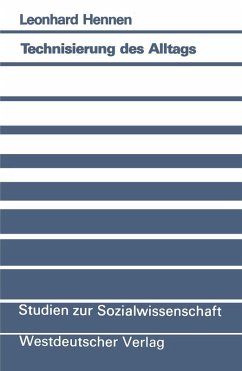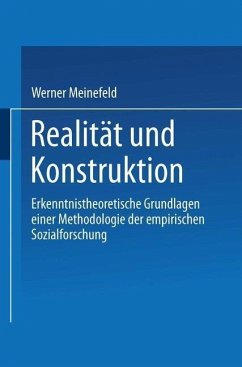
Verstehen als Konstruktion (eBook, PDF)
Literaturwissenschaft und Radikaler Konstruktivismus
Versandkostenfrei!
Sofort per Download lieferbar
Statt: 54,99 €**
35,96 €
inkl. MwSt.
**Preis der gedruckten Ausgabe (Broschiertes Buch)
Alle Infos zum eBook verschenken

PAYBACK Punkte
18 °P sammeln!
1. Einleitung . . . . . . . . . . . . . . . . . . . . . . . . . . . . . . . . . . . . . . . . . . . . . . . . . . . . . . . . . . . . . . . . . . . . 15 1. 1 Zur Theoriediskussion . . . . . . . . . . . . . . . . . . . . . . . . . . . . . . . . . . . . . . . . . . . . . . . . . . . . . 16 1. 2 Zur Darstellung der NELW . . . . . . . . . . . . . . . . . . . . . . . . . . . . . . . . . . . . . . . . . . . . . . . 23 1. 2. 1 Publikationen . . . . . . . . . . . . . . . . . . . . . . . . . . . . . . . . . . . . . . . . . . . . . . . . . . . . . . . . . . . . . . . . 23 1. 2. 2 Die neue Aufgabenstellu...
1. Einleitung . . . . . . . . . . . . . . . . . . . . . . . . . . . . . . . . . . . . . . . . . . . . . . . . . . . . . . . . . . . . . . . . . . . . 15 1. 1 Zur Theoriediskussion . . . . . . . . . . . . . . . . . . . . . . . . . . . . . . . . . . . . . . . . . . . . . . . . . . . . . 16 1. 2 Zur Darstellung der NELW . . . . . . . . . . . . . . . . . . . . . . . . . . . . . . . . . . . . . . . . . . . . . . . 23 1. 2. 1 Publikationen . . . . . . . . . . . . . . . . . . . . . . . . . . . . . . . . . . . . . . . . . . . . . . . . . . . . . . . . . . . . . . . . 23 1. 2. 2 Die neue Aufgabenstellung: empirisches Argument . . . . . . . . . . . . . . . . . . . 25 1. 2. 3 Die neue Aufgabenstellung: theoretisches Argument . . . . . . . . . . . . . . . . . 27 1. 3 Zur Darstellung des Radikalen Konstruktivismus . . . . . . . . . . . . . . . . . . . . . 29 1. 3. 1 Namensgebung . . . . . . . . . . . . . . . . . . . . . . . . . . . . . . . . . . . . . . . . . . . . . . . . . . . . . . . . . . . . . . 30 1. 3. 2 Zielsetzungen des Radikalen Konstruktivismus . . . . . . . . . . . . . . . . . . . . . . . . 32 1. 3. 3 Traditionen des Radikalen Konstruktivismus . . . . . . . . . . . . . . . . . . . . . . . . . . . 33 1. 3. 4 Einzelwissenschaften als naturalistische Grundlage des Radikalen Konstruktivismus . . . . . . . . . . . . . . . . . . . . . . . . . . . . . . . . . . . . . . . . . . . . . . 36 1. 4 Zur Gliederung der Arbeit . . . . . . . . . . . . . . . . . . . . . . . . . . . . . . . . . . . . . . . . . . . . . . . . 39 1. 4. 1 Uberblick fiber die entwickelten Theorien und grundlegenden Konzepte des Radikalen Konstruktivismus . . . . . . . . . . . . . . . . . . . . . . . . . . . . . 40 1. 4. 2 Uberblick fiber die entwickelten Theorien und grundlegenden Konzepte der NELW . . . . . .. . . . . . . . . . . . . . . . . . . . . . . . . . . . . . . . . . . . . . . . . . . . . . . . . 41 1. 4. 3 Diskussion unterschiedlicher Verstehenskonzepte . . . . . . . . . . . . . . . . . . . . . 42 1. 4. 4 Ausblicke . . . . . . . . . . . . . . . . . . . . . . . . . . . . . . . . . . . . . . . . . . . . . . . . . . . . . . . . . . . . . . . . . . . . 43 2. Der Radikale Konstruktivismus . . . . . . . . . . . . . . . . . . . . . . . . . . . . . . . . . . . . . . . . . . 44 2. 1 Erkenntnistheorie . . . . . . . . . . . . . . . . . . . . . . . . . . . . . . . . . . . . . . . . . . . . . . . . . . . . . . . . . . . 44 2. 1. 1 Was heiSt 'erkenntnistheoretische Grundlegung'? . . . . . . . . . . . . . . . . . . . . . 46 2. 1. 2 Selbstreferenz und Wirklichkeit . . . . . . . . . . . . . . . . . . . . . . . . . . . . . . . . . . . . . . . . . . 47 2. 1. 3 Die neue erkenntnistheoretische Aufgabenstellung . . . . . . . . . . . . . . . . . . . . 51 2. 1. 4 Historische Uberlegungen zum Programm einer konstruktivistischen Erkenntnistheorie . . . . . . . . . . . . . . . . . . . . . . . . . . . . . . . . . . 55 2. 1. 5 Systematische Fragestellungen einer konstruktivistischen Erkenntnistheorie . . . . . . . . . . . . . . . . . . . . . . . . . . . . . . . . . . . . . . . . . . . . . . . . . . . . . . . . . . . 60 7 2. 2 Naturalistische Grundlagen I: Biologie . . . . . . . . . . . . . . . . . . . . . . . . . . . . . . . . . . 63 2. 2. 1 Die Theorie autopoietischer Systeme . . . . . . . . . . . . . . . . . . . . . . . . . . . . . . . . . . . . 64 2. 2. 2 Autopoiese und Kognition . . . . . . . . . . . . . . . . . . . . . . . . . . . . . . . . . . . . . . . . . . . . . . . . . 70 2. 2. 3 Der Beobachter . . . . . . . . . . . . . . . . . . . . . . . . . . . . . . . . . . . . . . . . . . . . .. . . . . . . . . . . . . . . . 73 2. 2. 4 Autopoiese vs. Kognition . . . . . . . . . . . . . . . . . . . . . . . . . . . . . . . . . . . . . . . . . . . . . . . . . 76 2. 3 Naturalistische Grundlagen II: Neurophysiologie . . . . . . . . . . . . . . . . . . . . . 80 2. 3. 1 Das traditionelle Modell: Offenes System und Informationsaufnahme . . . . . . . . . . . . . . . . . . . . . . . . . . . . . . . . . . . . . . . . . . . . . . . . . . . . . 81 2. 3. 2 Das neue Modell: Geschlossenes System und Informationskonstruktion . . . . . . . . . . . . . . . . . . . . . . . . . . . . . . . . . . . . . . . . . . . . . . . . . .
Dieser Download kann aus rechtlichen Gründen nur mit Rechnungsadresse in A, B, BG, CY, CZ, D, DK, EW, E, FIN, F, GR, HR, H, IRL, I, LT, L, LR, M, NL, PL, P, R, S, SLO, SK ausgeliefert werden.












